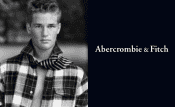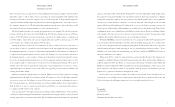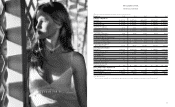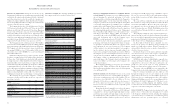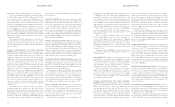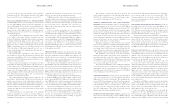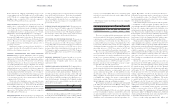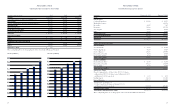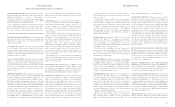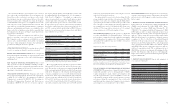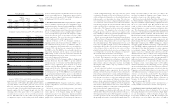Abercrombie & Fitch 2004 Annual Report Download - page 10
Download and view the complete annual report
Please find page 10 of the 2004 Abercrombie & Fitch annual report below. You can navigate through the pages in the report by either clicking on the pages listed below, or by using the keyword search tool below to find specific information within the annual report.
Abercrombie &Fitch
versus net income was due to the Company’s share repurchase
program in fiscal 2004. The Company repurchased 11.2 million
shares in fiscal 2004 versus 4.4 million shares in fiscal 2003.
FISCAL 2003 COMPARED TO FISCAL 2002 : FOURTH QUARTER
2003: NET SALES Net sales for the fourth quarter of the 2003 fiscal
year were $560.4 million, up 4.8% versus 2002 fourth quarter net
sales of $534.5 million. The net sales increase was attributable to the
net addition of 103 stores and an increase in the direct-to-consumer
business net sales of $8.2 million versus the comparable period in
the 2002 fiscal year, offset by an 11% decrease in comparable store
sales during the quarter.
By merchandise brand, comparable store sales for the quarter
were as follows: Abercrombie & Fitch’s comparable store sales
declined 14% with mens declining in the low twenties and womens
declining by a high-single digit percentage. In abercrombie, com-
parable store sales decreased 7% with girls achieving a low-single
digit positive increase and boys declining in the low twenties. In
Hollister, comparable store sales were flat when compared to fiscal
2002 for the quarter. Hollister girls comparable store sales were a
positive low-single digit for the fourth quarter, while guys were a
negative mid-single digit.
On a regional basis, comparable store sales results across all
three brands were strongest along the East Coast and in the West
and weakest in the Midwest. Stores located in Florida, Southern
California and the New York metropolitan area had the best com-
parable store sales performance.
From a promotional standpoint, the Company used direct
mail promotions during the fourth quarter of the 2003 fiscal year
to drive business between Thanksgiving and Christmas, but did
not anniversary the 2002 fourth quarter issuance of a bounce-back
coupon. Also, the Company did not repeat a 15%-off bag stuffer
coupon that impacted late December and January business in fiscal
2002. Overall, the Company sought to have a less promotional
look to the stores in the 2003 fiscal year.
From a merchandising standpoint, womens continued to out-
perform mens. In Abercrombie & Fitch, womens had strong com-
parable store sales increases in the fourth quarter in knits, fleece
and skirts. Weak classifications included woven shirts and outerwear.
The mens business continued to be difficult. However, graphic tees
and woven shirts were classifications that had comparable store
sales increases while the sweater and outerwear classifications had
significant decreases.
In the kids’ business, for the quarter, knits, sweats and pants
had strong comparable store sales increases in girls, which were
somewhat offset by weak business in sweaters, shirts, outerwear
and gymwear. Boys graphic tees, woven shirts and accessories had
comparable store sales increases, but these increases were not suf-
ficient to offset other weaker performing classifications.
In Hollister, girls also achieved stronger comparable store sales
than guys. In girls, sweats, skirts, pants and denim had significant
comparable store sales increases during the quarter, while the sweater
and outerwear classifications declined. In guys, woven shirts, denim
and sweats had positive comparable store sales increases.
However, the sweater, knit tops and outerwear classifications had
significant declines.
Direct-to-consumer merchandise net sales through the
Company’s web sites, the A&F Quarterly (a catalogue/magazine)
and catalogue for the fourth quarter of the 2003 fiscal year were $31.0
million, an increase of 28.6% versus last year’s fourth quarter net
sales of $24.1 million. The Company added a Hollister e-commerce
business during Back-to-School 2003. Shipping and handling rev-
enue for the corresponding periods was $3.5 million in 2003 and
$2.2 million in 2002. The direct-to-consumer business, including
shipping and handling revenue, accounted for 6.2% of net sales in
the fourth quarter of the 2003 fiscal year compared to 4.9% in the
fourth quarter of fiscal 2002.
GROSS INCOME The Company’s gross income may not be compa-
rable to those of other retailers since all significant costs related to the
Company’s distribution network, excluding direct shipping costs
related to the direct-to-consumer sales, are included in general,
administrative and store operating expenses (see “General,
Administrative and Store Operating Expenses” section below).
Gross income for the fourth quarter of the 2003 fiscal year was
$261.5 million compared to $244.2 million in the 2002 fiscal year.
The gross income rate for the fourth quarter of the 2003 fiscal year
was 46.7%, up 100 basis points from the 2002 rate of 45.7%. The
increase in gross income rate resulted largely from an increase in
IMU, partially offset by a higher markdown rate and an increase in
buying and occupancy costs, as a percent of net sales.
Continued progress in sourcing efficiency was an important fac-
tor in improving IMU and profit. The Company continued to make
progress increasing IMU in the Hollister and abercrombie business,
where IMU improved over 400 basis points versus the fourth quarter
of the 2002 fiscal year for both concepts. All three concepts operat-
ed at very similar margins, both in IMU and merchandise margin.
The increase in buying and occupancy costs, as a percent of
net sales, reflected the inability to leverage fixed costs, such as rent,
depreciation and other real estate related charges, with a compara-
ble stores sales decrease. The markdown rate, as a percentage of
net sales, exceeded fiscal 2002’s fourth quarter due to the weaker
than expected pre-Christmas business resulting in aggressive
markdowns in the back half of January.
The Company conservatively managed its inventory and
despite negative comparable store sales ended the fourth quarter of
the 2003 fiscal year with inventories, at cost, up 3% per gross square
foot versus the fourth quarter of the 2002 fiscal year.
GENERAL, ADMINISTRATIVE AND STORE OPERATING
EXPENSES General, administrative and store operating expenses
during fourth quarter of the 2003 fiscal year were $106.7 million
compared to $93.4 million during the same period in the 2002 fis-
cal year. The fourth quarter of the 2003 fiscal year general, admin-
istrative and store operating expense rate was 19.0% compared to
17.5% in the fourth quarter of the 2002 fiscal year. The increase in
rate versus the 2002 fiscal year reflects a loss of leverage due to the
double-digit drop in comparable store sales partially offset by lower
bonuses and efficiencies in store operations, distribution center
operations and the direct-to-consumer business.
During the fourth quarter of the 2003 fiscal year, store payroll
hours were reduced by 2% per average Abercrombie & Fitch adult store
and wages, in all three concepts, were held relatively flat. Store hours
were managed on a weekly basis in order to match hours with sales
volume. Overall, store expenses grew at approximately the same rate
as the Company’s square footage growth during the fourth quarter.
The distribution center achieved record level productivity
during the fourth quarter of the 2003 fiscal year. Productivity, as
measured in units processed per labor hour, was 18% higher than
the fourth quarter of the 2002 fiscal year. This increase was on top
of a 39% increase in the fourth quarter of fiscal 2002 and a 50%
increase in the fourth quarter of fiscal 2001.
Costs related to the distribution center, excluding direct shipping
costs related to the direct-to-consumer sales, included in general,
administrative and store operating expenses were $5.5 million for
the fourth quarter of the 2003 fiscal year compared to $4.9 million
for the fourth quarter of the 2002 fiscal year.
OPERATING INCOME Operating income for the fourth quarter
of the 2003 fiscal year increased to $154.8 million from $150.8
million in the 2002 fiscal year fourth quarter. The operating income
rate was 27.6% for the fourth quarter of the 2003 fiscal year compared
to 28.2% for the fourth quarter of the 2002 fiscal year. Higher gen-
eral, administrative and store operating expenses, expressed as a
percentage of net sales, reduced the operating income rate in the
fiscal 2003 fourth quarter. This decline was partially offset by
higher merchandise margins during the quarter.
INTEREST INCOME AND INCOME TAXES Fourth quarter net
interest income for the 2003 fiscal year was $1.1 million compared
with net interest income of $1.3 million for the comparable period in
the 2002 fiscal year. The decline in the 2003 fiscal year fourth quar-
ter net interest income was due to lower interest rates. The
Company continued to invest in tax-free securities. The effective
tax rate for the fourth quarter was 39.3% compared to 38.5% for the
2002 comparable period.
NET INCOME AND NET INCOME PER SHARE Net income for
the fourth quarter of the 2003 fiscal year was $94.6 million versus
$93.5 million for the same period in fiscal 2002, an increase of
1.2%. The increase in net income was the result of higher net sales
and higher gross income partially offset by increased spending in
general, administrative and store operating expenses.
Net income per weighted-average diluted share outstanding for
the fourth quarter of fiscal 2003 was $0.97 versus $0.94 for the fourth
quarter of fiscal 2002, an increase of 3.2%. Net income per share
increased by more than net income as a result of the Company’s
share repurchase program. In the fourth quarter of the 2003 fiscal
year the Company had weighted-average basic shares outstanding of
96.1 million versus 97.2 million in the fourth quarter of 2002.
FISCAL 2003: NET SALES Net sales for the 2003 fiscal year reached
$1.708 billion, an increase of 7.0% versus the 2002 fiscal year net sales
of $1.596 billion. The net sales increase was attributable to the net
addition of 103 stores and an increase in the direct-to-consumer
business net sales of $16.9 million versus the 2002 fiscal year, offset
by a 9% decrease in comparable store sales for the year.
By merchandise concept, comparable store sales for the 2003
fiscal year were as follows: Abercrombie & Fitch’s declined 11%
with mens declining in the low twenties and womens declining by
mid-single digits. abercrombie comparable store sales declined 6%
with girls achieving a mid-single digit increase and boys posting a
high-teen decrease. Overall, the women’s and girls’ businesses
continued to increase in share of the total business and accounted
for approximately 63% of the adult’s and kids’ businesses in the 2003
fiscal year. Hollister comparable store sales for the 2003 fiscal year
increased 7%, with girls achieving a low double-digits increase and
guys a slight decrease.
During the year, Hollister continued to gain in productivity
relative to Abercrombie & Fitch. For the 2003 fiscal year, sales per
square foot in Hollister stores were approximately 113% of the
sales per square foot of Abercrombie & Fitch stores in the same
malls compared to 86% for the 2002 fiscal year.
Direct-to-consumer merchandise net sales through the
Company’s web sites, the A&F Quarterly and catalogue for the
2003 fiscal year were $80.4 million, an increase of 22.0% versus net
sales of $65.9 million for the comparable period in fiscal 2002. The
Company added a Hollister direct-to-consumer business during
Abercrombie &Fitch
16 17


